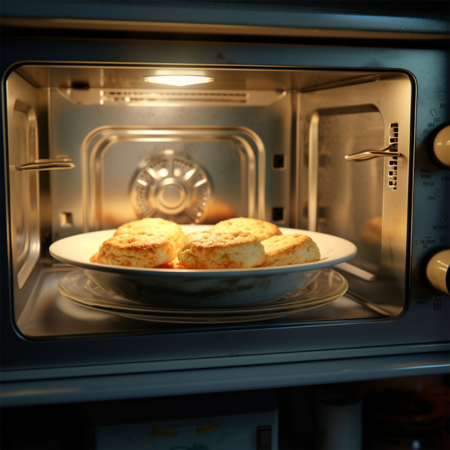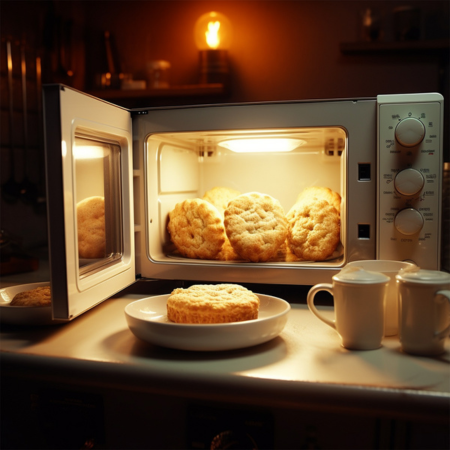Have you ever been in the middle of a biscuit-craving episode and realized you don’t have an oven, or perhaps it’s occupied with a roast dinner?
A question arises: Can you cook biscuits in the microwave? The answer is yes! However, it’s not as straightforward as popping them into the microwave and hitting the start button.
It’s a bit of a culinary adventure, blending convenience with the classic deliciousness of a biscuit.
So, if you’re ready for this scrumptious challenge, read on as we delve into the surprising realm of microwave biscuit baking.
Key Points
- Microwave biscuits differ from oven-baked in texture and taste.
- Ensure the dough is rolled out and not too thick.
- Use microwave-safe dishware to prevent damage or harm.
- Avoid overcrowding the microwave for even cooking.
- Monitor closely to avoid overcooking or undercooking the biscuits.
The Need-to-Know Basics Of Microwave Biscuit Baking
The Microwave Method
Microwaving biscuits is possible and the process is fairly simple. The trick is in the setup.
First, you need microwave-safe cookware. A microwave-safe dish or silicone baking mat works well.
Next, arrange your biscuits on the dish or mat. Space them out evenly. This ensures even cooking.
Now, cover the biscuits. Use a microwave-safe lid or another plate. This traps the heat, helping the biscuits to bake.
Cooking Time
Microwaves vary in power. It’s important to start with a short cooking time. Try setting your microwave for one minute initially.
After this, check the biscuits. They should be starting to rise. Put them back in for another 30 seconds if they’re still doughy.
Keep an eye on them. Overcooking can make them hard or rubbery.
Once they’ve puffed up and are slightly golden, they’re ready. Be careful; they’ll be hot.
So, yes, you can cook biscuits in the microwave. They may not be as crispy as oven-baked ones, but they’ll satisfy your biscuit craving fast!
Can You Cook Biscuits In The Microwave
The Ideal Microwave Biscuit Scenario
The ideal situation for microwaving biscuits is when you’re in a rush. Even better, when you have few ingredients on hand. But remember, taste is a trade-off.
Taste Trade-Off
Microwave biscuits won’t have the same flavor as oven-baked ones. This is because microwaves cook food differently.

They heat water molecules, cooking food from the inside out. Ovens, on the other hand, cook from the outside in. This difference influences the taste and texture of your biscuits.
The Result
So what’s the verdict? Microwave biscuits are an excellent quick fix. They won’t have the golden crisp of oven-baked biscuits. However, they’re light, fluffy, and ready in minutes. It’s a great option for a fast breakfast or snack.
Conclusion
In conclusion, microwave biscuit baking is a surprisingly viable option. Especially when you’re short on time or ingredients, the flavor may differ from oven-baked.
But, if you’re in a pinch, microwave biscuits can be a satisfying solution.
Selecting The Right Biscuit Dough For The Microwave
Not all types are created equal when choosing the right biscuit dough for the microwave.
Dough Consistency
The consistency of your dough matters. A wetter dough can be more forgiving in the microwave. It’s less likely to dry out. This results in a softer, fluffier biscuit.
Dough Ingredients
The ingredients in your dough also play a role. Dough with higher fat content tends to microwave better. Fats help keep the biscuits moist. They also contribute to a richer flavor.
Pre-Made Dough
Pre-made, store-bought dough is a convenient option. It’s usually designed to cook well under various conditions. This includes microwaving.
Homemade Dough
If you’re making dough from scratch, aim for a moist mixture. Add a little more liquid than usual.
Dough Balls
Another tip: keep the dough balls small. Smaller biscuits cook more evenly in the microwave.
In conclusion, the right dough can make a big difference. You can enjoy tasty microwave biscuits anytime with the right selection and preparation!
Step-by-Step Guide To Microwaving Biscuits
Prepping Your Dough
Start with the dough. Whether it’s homemade or store-bought, remember to keep it moist. If it’s homemade, add a bit more liquid than usual.
Shaping Biscuits
Next, form small dough balls. Smaller biscuits mean even cooking.
Microwave Setting
Microwave settings matter. Choose the high setting for the best results.
Cooking Time
Cooking time will vary. A general rule: start with a minute. Add more time if necessary.
Checking the Biscuits
After a minute, check your biscuits. Be careful; the microwave will be hot! Use caution when removing them.
Let the Biscuits Rest
Let the biscuits rest for a moment. This allows them to finish cooking from residual heat.
Enjoy Your Biscuits
Finally, enjoy your microwave biscuits! They’re fast, convenient, and satisfying. With this method, you can have biscuits anytime, anywhere.
Troubleshooting
Bad result? Don’t worry. Baking in a microwave takes practice. Adjust the dough moisture or cooking time. Experiment until you find what works best for you.
In conclusion, microwaving biscuits is a quick and easy method. It’s perfect for a quick snack or breakfast. Remember these simple steps, and you’ll have delicious biscuits in no time!
Tips And Tricks For Perfect Microwave Biscuits
Tip 1: Choose the Right Dough
Choosing the right dough is crucial. Opt for high-protein flour for better rise. Store-bought doughs work well too. Experiment with various brands to find your preference.
Always ensure your dough is moist. This guarantees fluffy results. Remember, practice makes perfect. Find the dough that fits your taste best.
Tip 2: Handle with Care
Handle your dough gently. Rough handling toughens it. Use a light touch when shaping. Avoid over-kneading. Each step matters.
Treat your dough with care for soft, tender biscuits. Practice patience for perfect results. Happy microwaving!
Tip 3: Experiment with Cooking Times
Microwaves vary in power. So does cooking time. Start with a short time—test for doneness. If needed, cook longer. Check regularly. Don’t overcook.

Dry biscuits are not tasty. Practice and adjust. Perfect biscuits need perfect timing. You’ll find your microwave’s sweet spot. Happy experimenting!
Tip 4: Use a Microwave-Safe Plate
Ensure you use a microwave-safe plate. Check the plate’s bottom for a symbol indicating microwave-safety.
Plastic wraps can melt and contaminate food, avoid them. Glass or ceramic plates are good choices. They distribute heat evenly for well-cooked biscuits. Remember, safety first! Enjoy your microwave biscuit journey.
Tip 5: Rotate your Biscuits
Rotating biscuits is key. This ensures even heating. Start at the microwave’s edge. Rotate midway through cooking.
This compensates for uneven microwave power. Your biscuits will be evenly cooked, not half-baked. This step can’t be skipped. It’s crucial. Patience is the secret ingredient. Enjoy your perfectly microwaved biscuits!
Tip 6: Monitor the Cooking Process
Cooking is an art. Don’t rush it. Observe your biscuits. Watch the color change. Smell them. They should smell heavenly. Look for a golden-brown hue.
If they are too pale, give them more time. If they are too dark, remove them. Don’t leave it unattended. Be vigilant. Perfect biscuits need your attention. Enjoy the process. Happy microwaving!
Tip 7: Biscuit Size Matters
Biscuit size impacts cooking time. Larger biscuits need more time. Smaller ones cook quickly. The uniform size ensures even cooking. Too big might cook unevenly.
Too small may become dry. Choose wisely. Size matters for perfect biscuits. Happy microwaving!
Tip 8: Let them Rest
After microwaving, don’t dig in immediately. Allow your biscuits a leisurely rest. This cooling period is vital. It lets them firm up. The residual heat continues cooking.
This finishes them off beautifully. They go from good to great. Wait for a bit. It’s worth it. Enjoy perfectly cooked, restful biscuits.
Tip 9: Experiment & Learn
Microwaving biscuits is an art to master. Each attempt brings learning. Experiment with types and sizes. Adjust microwave settings.
Maybe you prefer them softer. Or perhaps you like a harder crust. There’s no set formula. It’s all about your taste. Keep experimenting. Keep learning. Keep enjoying. Happy microwaving!
Tip 10: Enjoy the Process
Most importantly, have fun! Making microwave biscuits should be an enjoyable experience. Enjoy your tasty creations!
Common Mistakes To Avoid When Microwaving Biscuits
Mistake 1: Using the Wrong Dough
An improper dough selection can lead to dry, crumbly biscuits. Moist and soft dough is optimal for microwave biscuits.
Mistake 2: Overworking the Dough
Manhandling the dough results in tough biscuits. Handle it gently to maintain tenderness.
Mistake 3: Incorrect Cooking Time
Every microwave is unique. Cooking times vary and incorrect timing can result in undercooked or burned biscuits.
Mistake 4: Non-microwave Safe Plate
Using plates that aren’t microwave-safe can cause them to crack or explode. Always use microwave-safe dishes.
Mistake 5: Uneven Cooking
Not rotating your biscuits leads to uneven cooking. Rotate them halfway through for uniform heat distribution.
Mistake 6: Lack of Monitoring
Neglecting your biscuits while they cook can result in overcooking. Regular checks are essential.
Mistake 7: Oversized Biscuits
Large biscuits don’t cook evenly in the microwave. Smaller biscuits guarantee even cooking.
Mistake 8: Not Allowing Rest Time
Skipping the rest time can result in undercooked biscuits. Always let them rest post-cooking.
Mistake 9: Giving Up Too Soon
Getting disheartened by initial failures is common but practice makes perfect. Persevere and keep trying.
Mistake 10: Not Enjoying the Process
Making biscuits should be fun. If it feels like a chore, you’re missing the point! Enjoy the process and the tasty rewards.
Conclusion
Microwaving biscuits is an art. Avoiding common mistakes can make it perfect. The right dough and gentle handling aid tenderness.
Correct timing and rotation ensure even cooking. Monitoring and correcting biscuit size prevent overcooking.
Rest time is key. Persistence and enjoyment enhance the biscuit-making experience. Happy microwaving!
- Can You Scrap A Microwave And Why You Should? - May 13, 2024
- Can You Put Metal In A Convection Microwave: 10 Major Risks - May 12, 2024
- Can You Use A Microwave Without The Glass: 10 Benefits - May 11, 2024

